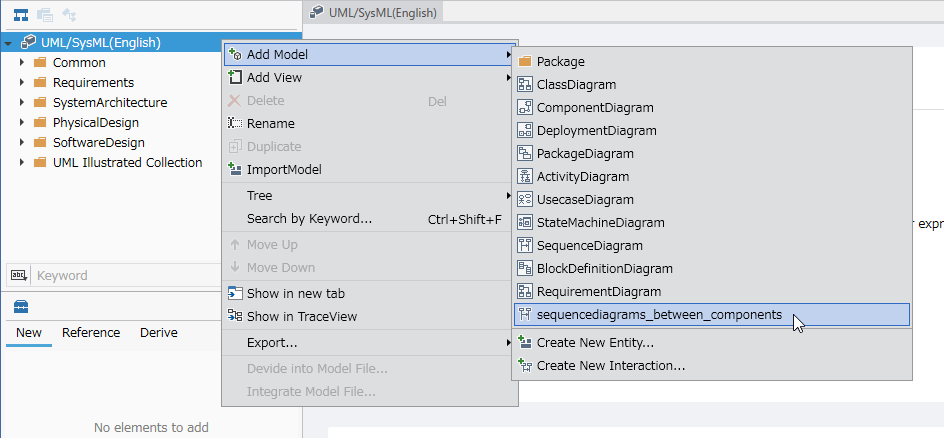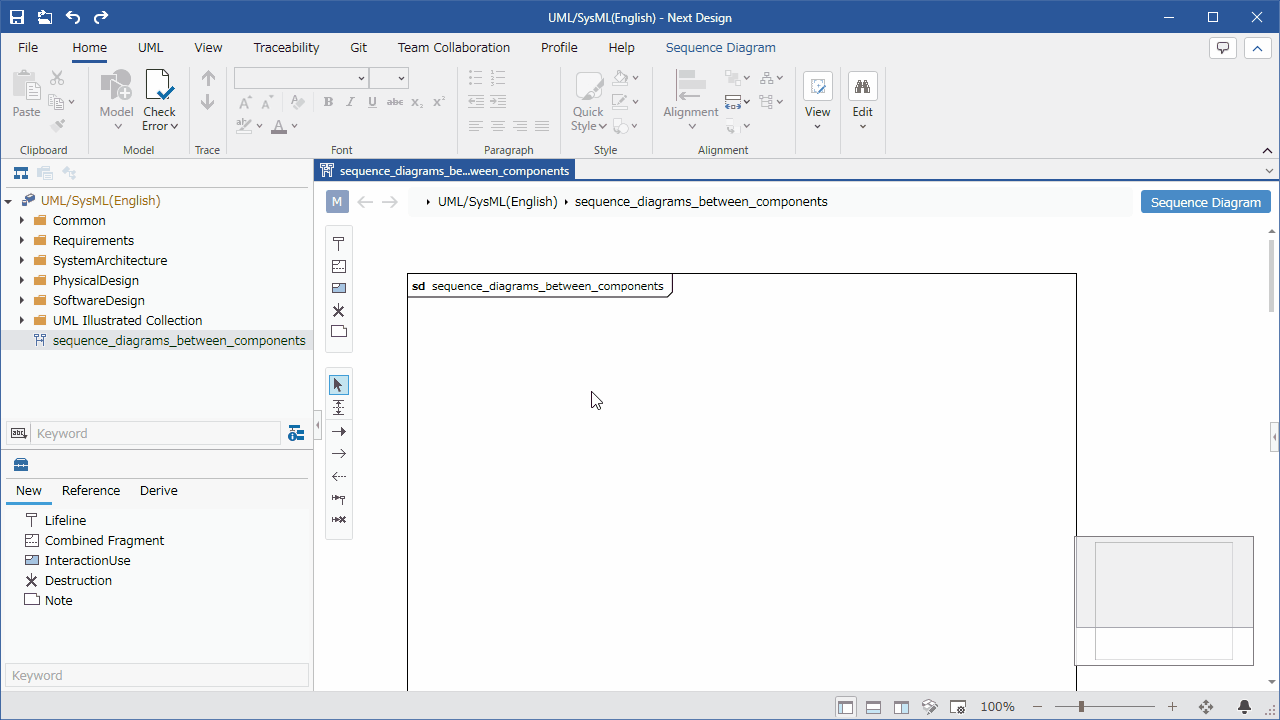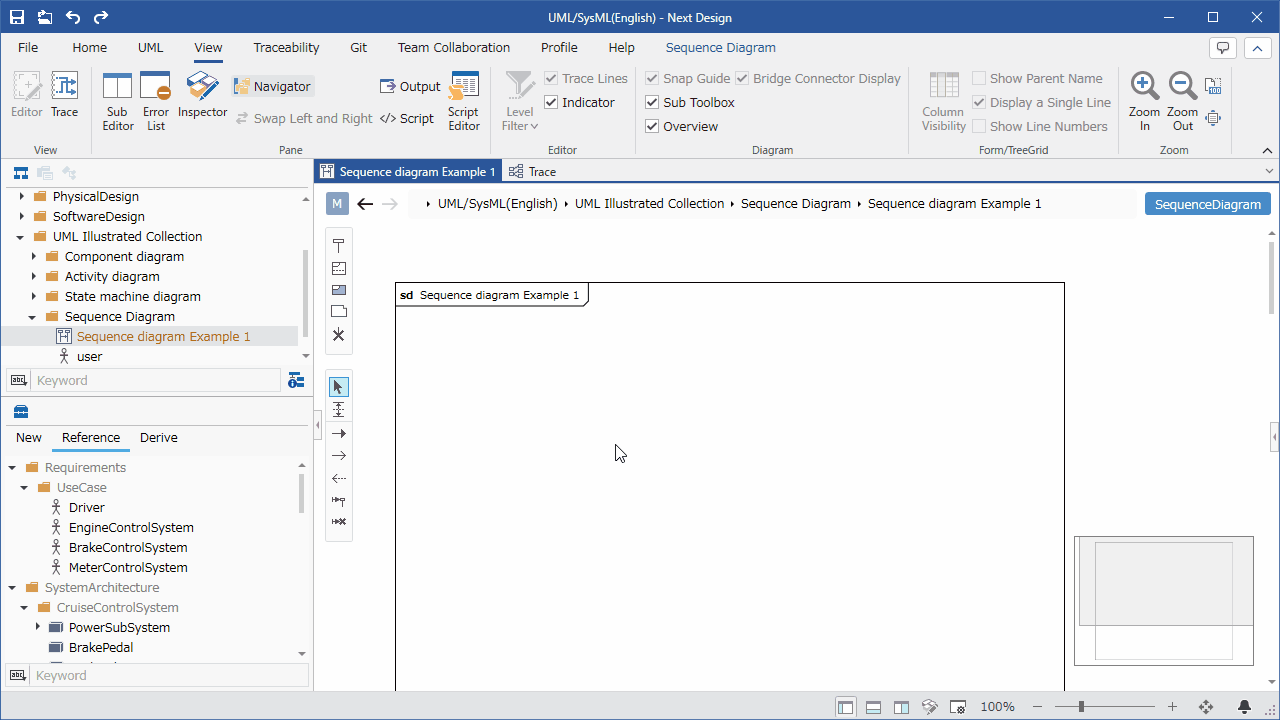Edit sequence diagram
Overview
Next Design's sequence diagram allows you to add an existing model as a lifeline and select a message according to the model to which the message is sent when describing the interaction between objects. For example, a component defined as a model can be added as a lifeline. Then, when adding a message between components, you can select the destination port for the message from those provided by the destination component.
The sequence diagram editing operations are described below in the following order.
- Add models for sequence diagrams
- Edit lifelines and messages
- Add model as lifeline
- Select message according to model
- add composite fragment
- Add use of cross-references
Add model for sequence diagram
To add a sequence diagram model, add it from the context menu of the model navigator, just like adding other models.

- The types of sequence diagrams that can be added (e.g. sequence diagrams between components) are defined by the profile.
Edit lifelines and messages
To add lifelines and messages between lifelines to your sequence diagram:

- Add a lifeline by dragging and dropping [Lifeline] from the [New] tab of the toolbox or the sub-toolbox at the left end of the editor editing area.
- Edit the name of the added lifeline.
- Move the pointer over the lifeline from which you want to send the message.
- Add a message by dragging the [▲] icon displayed on the left and right of the lifeline and dropping it on the lifeline to which you want to send the message.
- Edit the name of the added message.
- To add a non-synchronous message (asynchronous, reply, generate, destroy), select the message type in the sub-toolbox and then add the message.
About moving :::info messages
-
You can move to the next by dragging the message in the sequence diagram in combination with a key.
Element Operation Action Message alt + up/down drag -
By associating a note with a message and selecting the note and the message at the same time, you can move the note and the message synchronously.
-
After pressing the [Move all elements] button on the subbar, you can move all the elements together by dragging the [Move line] on the editor.
:::
- For sequence diagrams that do not fit in the editing area of the editor, by moving the pointer inside the frame of the sequence diagram and operating the wheel, you can fix the object name at the top of the lifeline and scroll only the bottom of the lifeline.
- While adding a synchronous, asynchronous, response, generate, or discard message from the sub toolbox, you will not be able to edit any of the following except message addition until message addition is completed or canceled.
- You will not be able to create note anchors.
- You will not be able to add lifelines, discards, notes, message ends, compound fragments, or use interactions.
- Composite Fragment operators can no longer be changed by double-clicking.
Add a model as a lifeline
To add an existing model as a lifeline in a sequence diagram, do the following:

- If the metamodel defines the types of models that can be added to a lifeline, click the Reference tab in the toolbox to see the models that can be added.
- Drag a model from the [Reference] tab of the toolbox and drop it on the editor to add it as a lifeline.
- The label of the lifeline immediately after being added shows only [Model Name] and the name of the lifeline is empty. Enter individual names as desired.
You can assign a new model to an existing lifeline or change it to another model by following the steps below.
- Select the lifeline to change and execute [Change Lifeline Type] from the context menu.
- Select the model to be assigned to the lifeline and press the [OK] button to display the [Model Name] defined in the metamodel on the label of the lifeline.
- Changing the type of a lifeline (the model assigned to a lifeline) resets the type of messages being sent to that lifeline.
Select message according to model
To select the destination model when adding a message, follow these steps:

- If message choices (target fields to associate with messages) for the model are defined in the metamodel, when you try to add a message in the same way as in "Edit lifelines and messages" above, the choices will be displayed. Masu.
- If you select a message and press the [OK] button, the message will be added and the [Title] defined in the metamodel will be displayed on its label.
- You can add a freely editable message regardless of the model by selecting "(Unassociated)" when selecting the message.
You can change the type of an existing message to match your model as follows:
- Select the message to change and execute [Change Message Type] from the context menu.
- After selecting the type to assign to the message and pressing the [OK] button, the label of the message will be changed to [Title] defined in the metamodel.
Add a composite fragment
To add a composite fragment to a sequence diagram, for example branching, do the following:

- Add a composite fragment by dragging and dropping [Fragment] from the [New] tab of the toolbox or the sub-toolbox at the left end of the editor editing area onto the live line of the editor.
- Double-click the operator (default: alt) on the top left of the composite fragment to edit it.
- Double-click the guard of the operand in the compound fragment to edit it.
- If you want to add an operand inside the compound fragment, select Add Operand from the context menu of the compound fragment.
- If you want to change the order of the operands in the compound fragment, point to the guard of the operand and drag and drop.
- Composite fragments can only be added/moved to places with lifelines.
Add cross-reference usage
To add the use of cross-references to your sequence diagram, follow these steps:
- From the [New] tab of the toolbox or the sub toolbox at the left end of the editor editing area, drag and drop [Use Cross Reference] onto the editor to add the use of cross reference.
- Select the cross-reference usage you added and click Relate Cross-Reference on the context menu.
- Select the sequence diagram to reference.
- To jump to an associated sequence diagram, double-click the cross-reference usage or select the cross-reference usage and click Show Associated Cross-References on the context menu.
- The use of cross-references is only associated with sequence diagrams. It cannot be associated with a message.